15 Best Node JS Frameworks Used For Web & Enterprise in 2019

Node JS is immensely recommended technology for developing scalable, advantageous and optimized web application solution.
Mostly used adjectives for describing Node JS particularly are fast, simple, easy yet flexible. Before the prior invention of Node JS developers faced an issue of using different languages for a client-side and server-side script where JavaScript consistently used for client-side scripting along with HTML code.
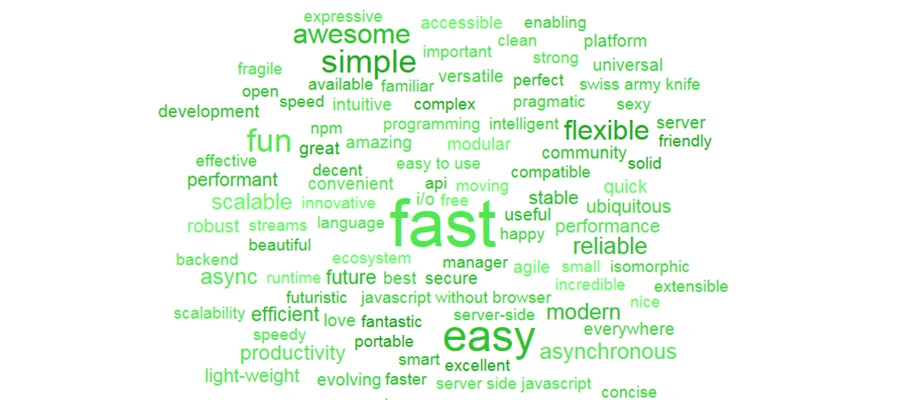
Discovery of Node JS represents server-side scripting with JavaScript that ultimately used to generate whole dynamic contents or web pages; the stated issue was the major bottleneck in web development that was vanished by Node JS as it allows the use of JavaScript for both client and server side.
Node JS is runtime JavaScript that runs outside the browser and used to working on server-side using a v8 engine. Acceptance for Node JS is not a miracle – it’s dynamic, light-weight, an adaptive nature includes NPM world’s huge ecosystem library that offers considerable features.
Moreover, node js development brought speed and cross-platform compatibility in back-end development. It has earned lots of popularity in a shorter period of span, more of in recent days acclaimed companies like Netflix, PayPal, Microsoft, and LinkedIn are relying on Node JS for steering up their infrastructure and software security requirement; it examines the bulk of data in lesser time, without compromising on quality and performance of each request.
Most of the developers will love one framework over other for various reasons and prospects, but they guaranteed to boost up the power of development cycles.
With a large variety of these choices, we bought to you insightful look at some of trendy frameworks and libraries catered by Node JS API framework; let’s take a deep comprehensive look of it.
Redirect to your favourite Framework
–>List of Best Node JS Frameworks
1] Express JS
Fast, Unopinionated minimalist web framework for Node JS; it might be the finest choice for rapid prototyping or highly customized solutions.
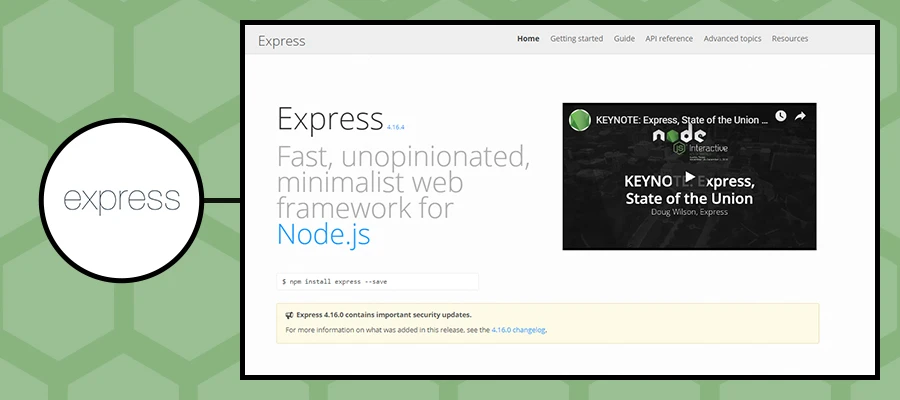
Express is an open-source server-side framework which is flexible, simpler, extensive and great performance speed; usually recognized as best Node JS framework.
- No of express customers: 1,128,273
- No of live websites: 236,623
- Achieve an award for 20th most popular framework in India
- Received an award for 15th most popular in the top 100k sites in Framework
(Source: Built with Trends)
Express is actually light-weight in its core configuration, specially designed to essentially functioning as middleware along with routing framework. Express does its responsibility in a fantastic way thus; the fact is it’s become part of the most acclaimed MEAN stack for Node.js
Highlights:
- It allows using the same language for both front and back-ends which ultimately improve application development speed
- It handles multiple I/O request with ease
- It minimizes spent expenses as it simplifies the process of developing a mobile app and making it well systematic
- Backed by large online support community
- With use to middleware packages integration of third-party tools become done with decency
- Easy to learn as it comes up with well-documented format along with large community support
Drawbacks:
- Difficult to understand event drive (callback) approach as Node Js is a single threaded framework that listens to various events and executes registered callbacks.
- Often times the philosophy of main concept “middleware” is important to understand before start executing stuff.
Website URL:https://expressjs.com/
2] Sail JS
Real-time MVC framework for Node JS, Sails offers easy to build custom and enterprise-grade Node js application
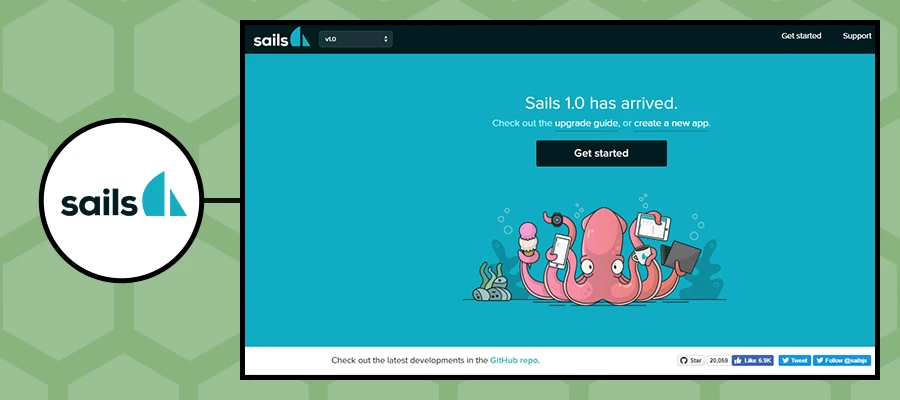
Sail JS is the most famous MVC framework for Node.js which is designed to emulate the familiar MVC patterns along with support of data-driven API’s that follows scalable approach and service-oriented architecture.
- No of customer: 8412
- No of live websites: 2225
- Received an award for the 5th most popular framework in India
- Achieved award for 5th most popular in the United States in Node JS
(Source: Built with Trends)
Sail offers a rich set of scaffolding that provides access to developers for creating RESTful API without writing any code. It also comes up built-in support for WebSockets with Socket.io which support numerous databases for various usages.
Highlights:
- Well-organized code optimization and blueprint
- Inbuilt support for WebSockets
- Assistance by distinct databases
- High level of data validation
- Maintained documentation
- Flexible, modular architecture with hooks and plug-in
Drawbacks:
- Dizzy learning curve
- Opinionated
Website URL:https://sailsjs.com/
3] Hapi JS
A rich framework for building applications and services, it enables developers to get more focus on writing reusable application logic rather than building infrastructure.
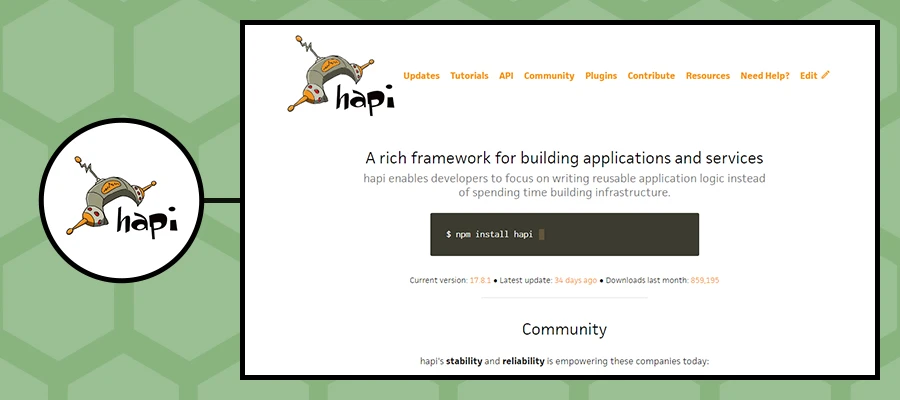
Hapi provides built-in support for input validation, authentication, caching, and other features along with extensive support of third-party plug-ins. Moreover, Hapi offers a great amount of control over request handling.
Highlights:
- Pick and select modules for scaling up application; offers plug-in based architecture
- Performance is improved compared to another framework;
- It provides configuration files as it believes in the configuration-centric approach
- It has rich web functionalities that ultimately boosting up application development
- Hapi has well-detailed API documentation for the easy learning curve
- It has proven track records & support from the community
- Segregation of business logic and scalability made simpler as it supports MVC
Drawbacks:
- Majorly developers need to figure out code structure on their own
- Refactoring can be done manually
- Testing of Endpoint executed manually
Website URL:https://hapijs.com/
4] Total JS
Total JS offers full features for creating server-side development; Fast & furious, powerful web solutions, eCommerce and REST services in Real-time zone.
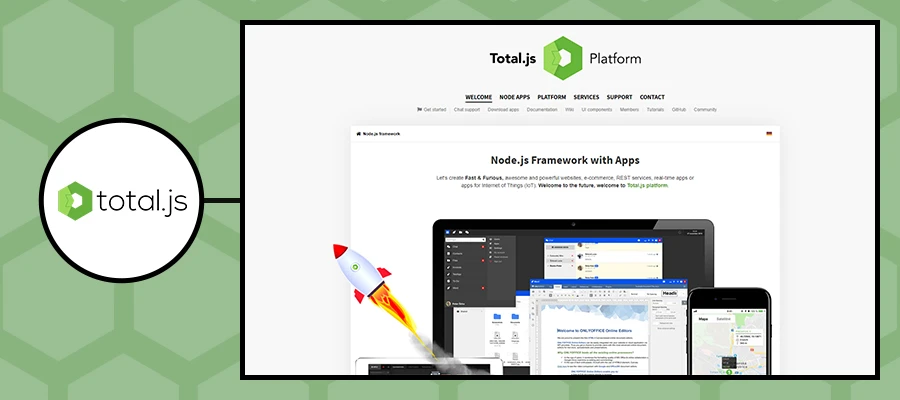
Total JS presents itself as a full-featured framework with a server-side focus; it provides supports to MVC architecture, image processing, RESTful routing and many more- which are mandatory stuff in each of the technology.
It supports SMTP email procedure; more of it uses low CPU requirement and extremely lightweight along with no dependencies at all.
Highlights:
- It follows MVC architecture convention that simply places relevant distinct model/view/controller folders and completes another task with ease
- It provides a greater amount of support for RFC 6455, and by that WebSockets
- Simple routing mechanism
- Require effortless mapping declaration for each route to JavaScript function
Drawbacks:
- Total JS should be not preferable for most application as incorporating within the existing project to another is a hard-sell
- Migrating from one platform to another is difficult in the case when you might already be dependent on another framework
Website URL:https://www.totaljs.com/
5] Moleculer JS
High- Performance Micro-services framework; which provides maintainability, vulnerabilities and code quality

It’s an open-source efficient and flexible framework with MIT approved license. Moleculer consists most of all essential micro-services.
Highlights:
- Follow request-reply concept
- Extensive support for middleware
- Pluggable transporters (Redis, MQTT)
- Manage Load balancing algorithm (round-robin)
- Inbuilt auto-discovery services
- Metrics that support health monitoring and its relevant statistics
- Moleculer is fault-tolerant benefiting for load balancing and circuit breaker
Drawbacks:
- Moleculer is somewhat limited while compared with Express and Koa
- It offers limited options for setting up of APIs or higher demands of an enterprises API
Website URL:https://moleculer.services/
6] Locomotive JS
Compelling MVC web framework for Node JS; It supports MVC patterns, Restful routings, convention over configuration at the time of integrating effortlessly with any databases or template engine.
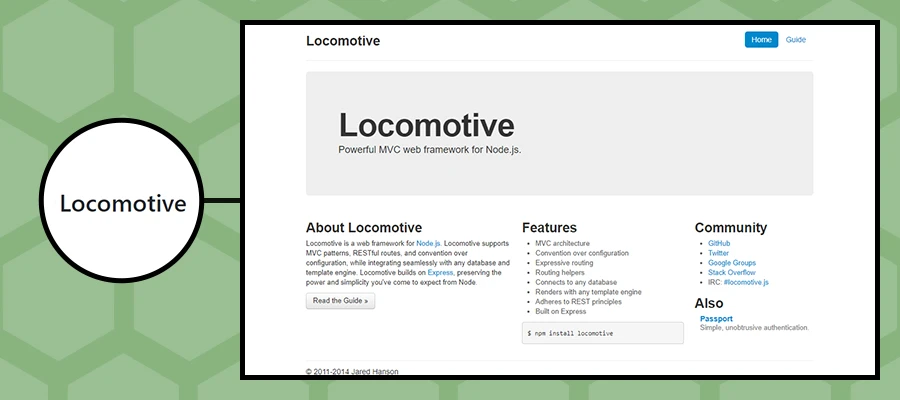
Locomotive takes help of Express, and conserving the effect with simplicity, this is what developers expect from Node. Locomotive offers smooth integration with other databases and templating platform which is an extraneous benefit to this extensive framework.
Highlights:
- Extensive support for MVC architecture
- Discussing at the time of configuration
- Well-expressive routing steps
- Portable with any databases
- Contributing to any template engine
- Heeded to REST principles
- Built upon Express
Drawbacks:
- For abrupt considering of Locomotive, you must need to know Express JS as it builds upon Express Js
Website URL:http://www.locomotivejs.org/
7] Koa JS
Advanced level generation web framework for Node JS; Koa introduced with the aim to be a smaller, highly expressive and most robust development for web application and APIs.
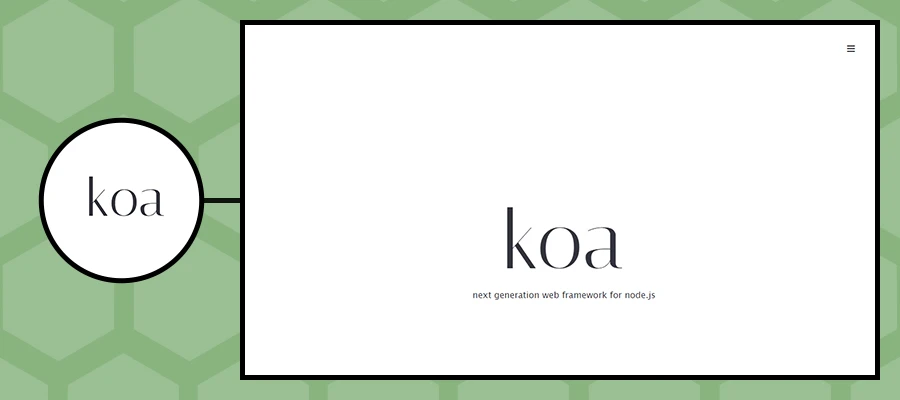
It leveraging on async functions and allows you to ditch callbacks and effortlessly increase error-handling. Kos does not accumulate any middleware within its core and offers dignified suits of methods which make writing servers agile and pleasing.
Highlights:
- Well-organized error handling mechanism with use of try/catch
- Koa is more modular
- It relies less on middleware
- It provides better user experience with its dynamic effects
- Development team already has proven records
- Extremely light-weight with compared to another framework
- Provide support for sync or await keywords and has transcended generator functions
Drawbacks:
- Its owning relatively less community
- Less compatible with express style Middleware
- It usually uses generators which are not compatible with another type of node js framework
Website URL:https://koajs.com/
8] Nest JS
Revolutionary Node JS framework for building efficient, reliable and scalable server-side applications; Due to its modular architecture it allows developers true flexibility for using any of libraries
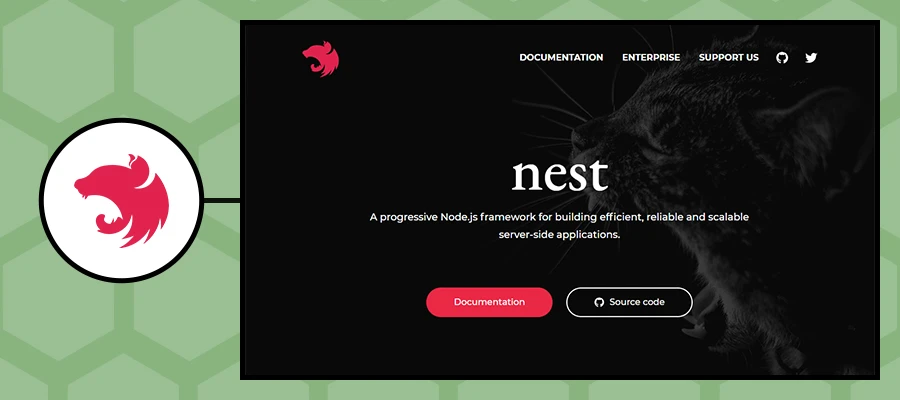
It follows a versatile approach; the adaptable ecosystem provides the full backbone for each and every server-side application. Although, it takes benefits of the latest JavaScript features with design patterns and mature solutions for node js world.
- Numbers of weekly downloads: 61.907
- Latest version: 5.5.0
(Source: checklyhq.com)
Nest JS uses TypeScript, a powerful superset of JavaScript. If you as a developer aware with Angular, which also using TypeScript, you will not face problem building your backend with Nest JS as all its component and structure looks same.
Highlights:
- Nest JS support dependency injection container along with factory injections too
- Every logical section of application which lives within same domain boundary is a module that encourages encapsulation in terms of modularization
- With the support of Dic (Dependency injection container) and modularization testing ability of Nest JS is improved
- Automatic code splitter for faster page loading
- Nest JS used to write things in TypeScript, types are good.
Drawbacks:
- Often-times malfunctioning is a major concern to be solved at the same time.
Website URL:https://nextjs.org/
9] Diet JS
A teeny, fast and modular node.js web framework, beneficial for building rapid, scalable applications, and APIs.
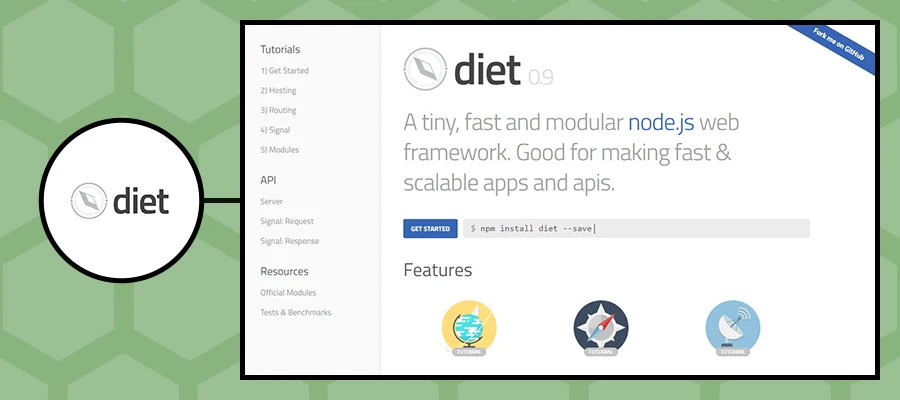
Diet offers host controller which can easily serve one or multiple hostnames, a router which can write clean API’s and URL’s from the scratch.
It handles the Node’s request and response object efficiently; more of it can extend the application with great features, associated modules; Diet is open-source, so developers are free to use, edit and contribute here.
Highlights:
- Diet is significantly fast compared to its alternatives
- Maintenance cost is less and manageable in nature as its small in size
- As Diet is optimized and using lower numbers which result in better performance
Drawbacks:
- It generally can be useful for smaller or start-up level of application
Website URL:http://dietjs.com/
10] Meteor JS
Meteor provides the fastest way to develop web, mobile, and desktop based application with use of open-source code.

Meteor accomplish code is in 10 lines instead of 1000 lines of code, credit ultimately goes to JavaScript stack which extends from databases to the user’s screen.
Moreover, you can use same code whether you are planning to develop web, iOS, Android or desktop based applications. Its hosting services push new features without the approval of app store or weren’t pulling users for downloading new native applications updates.
Highlights:
- Meteor believes in simplicity reason to opt for the very framework is full-stack characteristics
- Support of myriad packages and built-in libraries
- Effortless client and server communication
- Debugging procedures is quite easy to execute
- It provides real-time testing tools name “velocity” in addition to its core functions and enables with its syntax
Drawbacks:
- SSR service (extremely essential for search engine optimization) is unavailable in meteor
- Meteor officially not offering Mongo DB support though you can access other available recourses
- Less network connection flexibility
Website URL:https://www.meteor.com/

11] LoopBack
LoopBack is a highly-expensive, open-source Node.js framework for creating web and mobile app solutions.
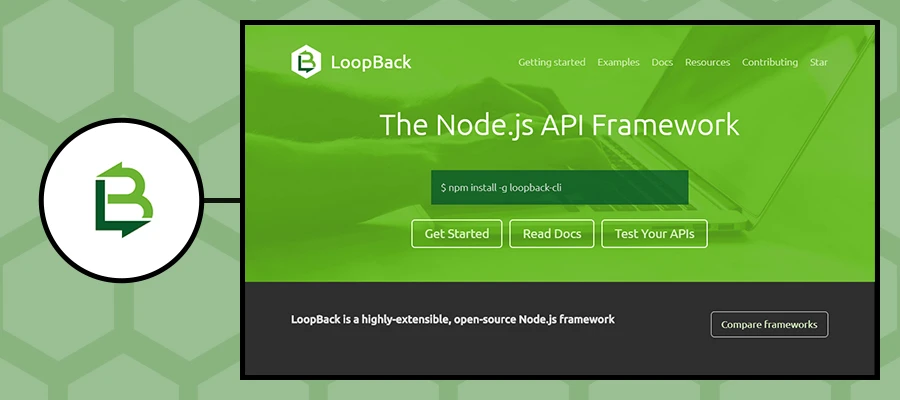
LoopBack is designed to ground up and connect apps to data using APIs; with packaging an API explorer variety of generators will implement it’s in code generators.
LoopBack is convenient solutions for a wide range of both smaller projects and enterprise performance. More of, it boasts an impressive amount of extension, database migration, and built-in modules.
We need to note that many developers have partnered with IBM to create IBM API connects, which building upon open-source and offers a range of tools that promise to make development faster. LoopBack also provides support for executing Ajax calls from the client to your relevant server.
Highlights:
- LoopBack provides full-stack development for web and mobile solutions
- Built-in models and features which ultimately boosting up the development speed
- Most importantly it is backed by IBM
- With the use of LoopBack, you can use built-in Users and access role features
Drawbacks:
- It follows the monolithic architecture
- Arduous learning curve
- It is quite impossible to execute the LoopBack framework in large or long-term projects
- Major libraries are paid which conclusively increase app development cost
Website URL:https://loopback.io/
12] Restify
Bright future of Node JS REST development; this optimize web services for building semantically accurate RESTful web services ready for production use at scale.
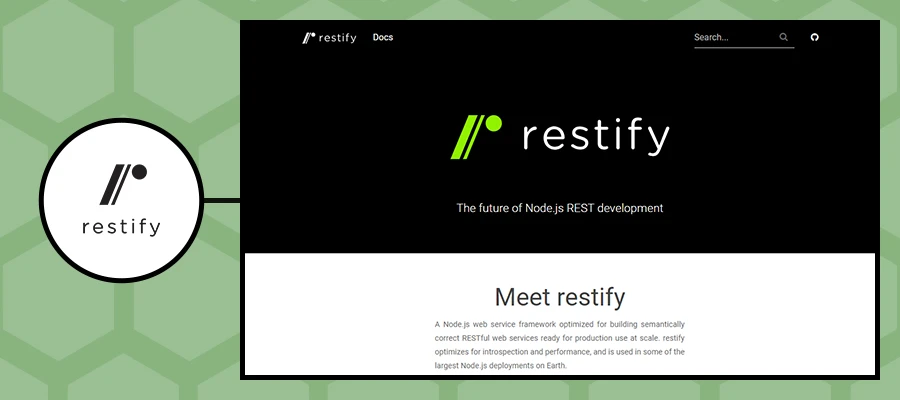
Restify amended for introspection and performance, more of used in some the largest Node JS development. Although, restify is acknowledged by some of the industries renowned companies for powering up some of the huge development.
Adequate debugging tactics that can track problems back to their origin by separating noise from the signal.
Highlights:
- Automatic DTrace support all require handlers(most essentially the parent platform should be comfortable with DTrace)
- It having unnecessary functionalities such as templating and rendering
Drawbacks:
- Lots of manual activities are needed
Website URL:http://restify.com/
13] Frisby
The easiest Node JS REST API testing framework out there; it offers REST API testing with ease, fast, and fun.
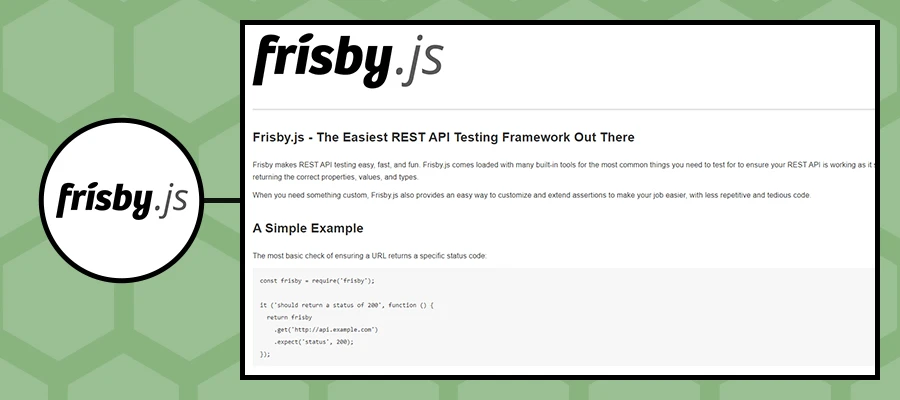
Frisby has inbuilt tools for the most common things which need to test to ensure whether REST API is working well or not, and returning the correct properties, and values
Moreover, if you are in need of fully-customized solutions; Frisby is an easy and best way to custom your job with less monotonous tasks.
Highlights:
- Speed is a major benefit that Frisby offers
- It makes testing API endpoints fun, and enjoyable with its inbuilt functionalities
- Offers consistency in API response structure, Keys and types
Drawbacks:
- Unorganized document structure, incomplete document
- The syntax is also somewhat different than alternatives which make feel tedious for a newbie
- It doesn’t support rolling back of transactions
Website URL:https://www.frisbyjs.com/
14] ActionHero
The reusable, scalable, and faster node js API server for stateless and stateful application

ActionHero is a fully-featured framework that offers collections of advanced functions; most importantly noticeable feature is it supports delayed tasks, it simply means task could be constructed to run on any time from any device which makes it portable across a wide variety of executions.
Highlights:
- It provides light implementation, built in code is fun and simple that result in extremely fast execution of code
- Easy and understandable routing;
Drawbacks:
- As ActionHero is new in framework family; so it’s not been run through the investigation that other implementations and framework already have
- It not always an outstanding choice for enterprise solutions or for faster development of full API systems
Website URL:https://www.actionherojs.com/
15] Facet
Breakneck JSON API development
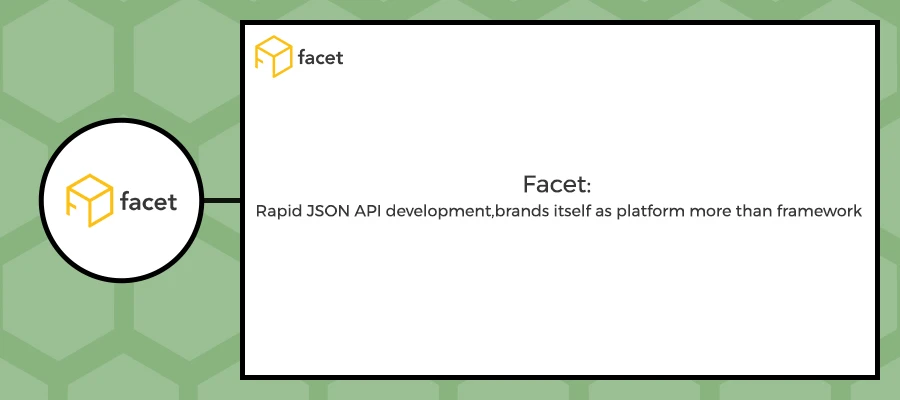
Facet represents itself as lesser a framework more of as Platform; the main purpose is to provide “extensile common utility classes that can able to develop rapid JSON API development”; due to this approach it purposefully brings in center of attraction for identifying tools for making easier development.
Highlights:
- Facet is really the best tool for long-term development in a variety of development and the framework’s entire duration
Drawbacks:
- Facet is lacking comprehensive documentation on its official website
- The absence of momentous amount of example code; simply means provider to adopt facet, they would like to have the battle to figure out the source code
Website URL:https://www.npmjs.com/facet
Bottom Line:-
Node JS is elegant yet extremely powerful JavaScript tech-stack which used to develop the highly-customized and real-time application. Therefore, if you are planning to develop your business idea from scratch; also planning for hiring full-service web and mobile Node JS Development Company at that moment your exploration ends here;
Magneto IT Solutions is full-services Provider Company having a team of adroit professionals who can cultivate your imaginations into reality, by hiring developers from the well-established company would be a profitable decision for increasing your ROI on business.
Although, when it comes to examining the type of framework with its worth for your proposed need, we always need to consider such inspection carefully:
- Huge and live community support
- Open discussion on GitHub
- Able to Scale based on future need
- Peak Load-tolerance
- Well-systematic documentation
Additionally, as there is an overabundance of frameworks available and some of them might be unknown through our main motive must be analyzing stable, well-organized and great performance framework so it would be a blessing, not a constraint.



